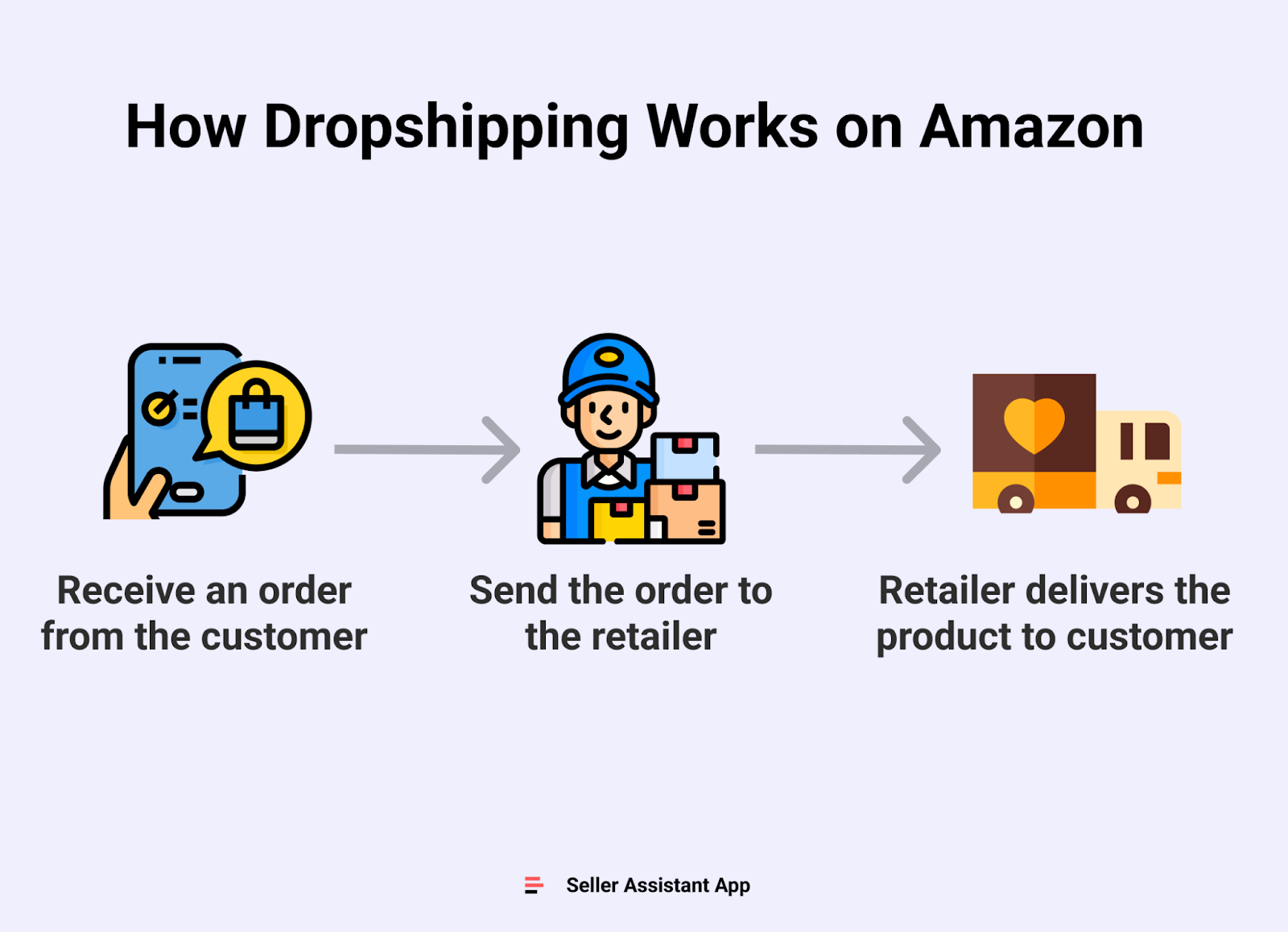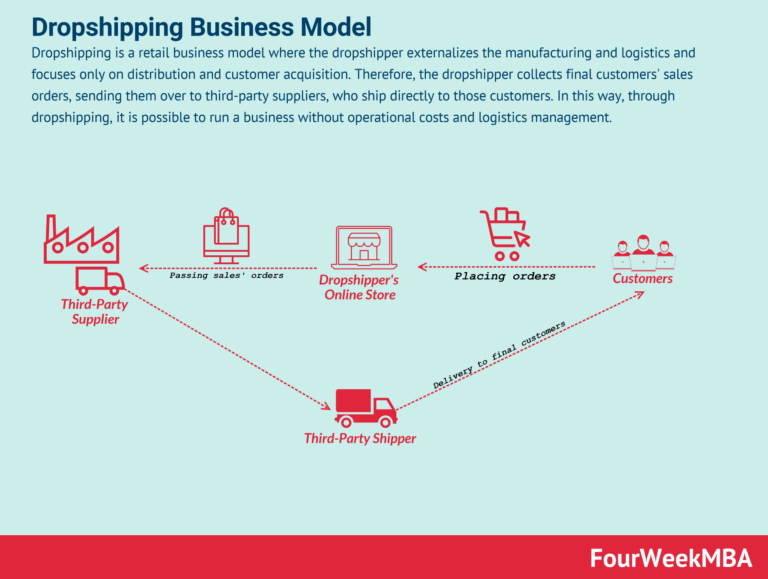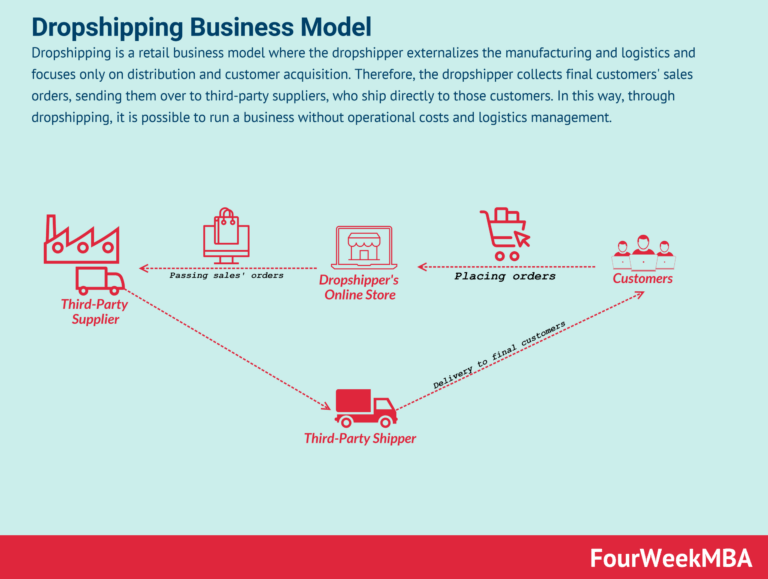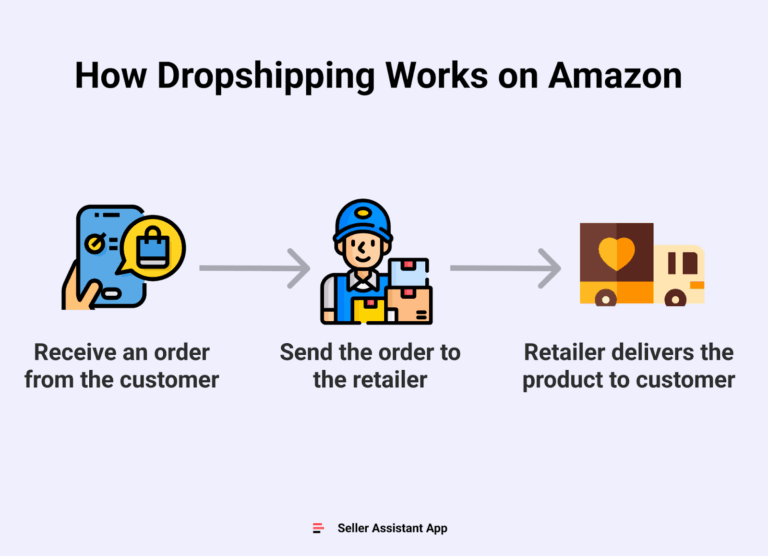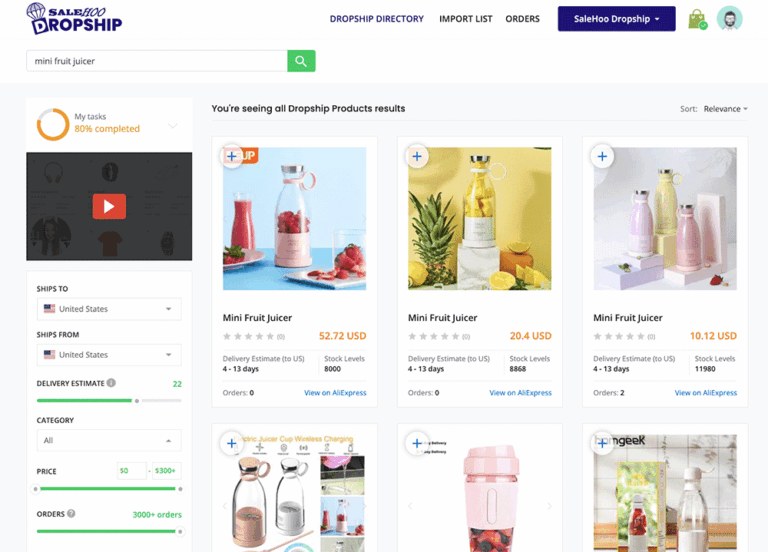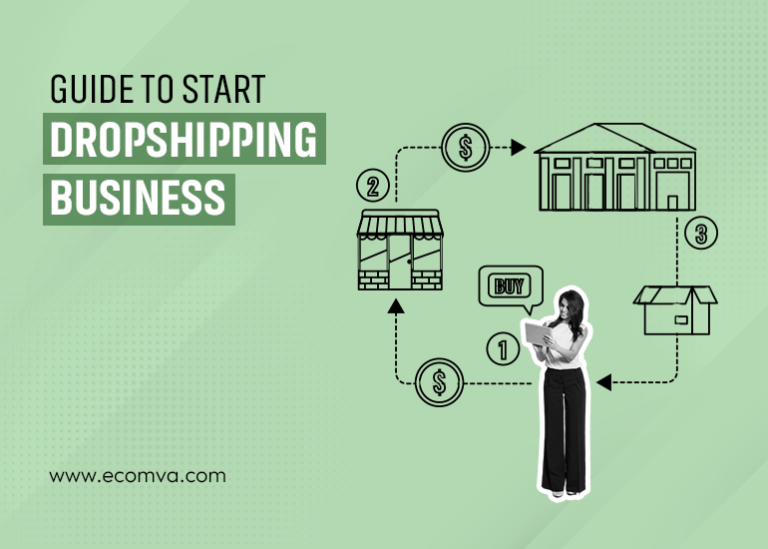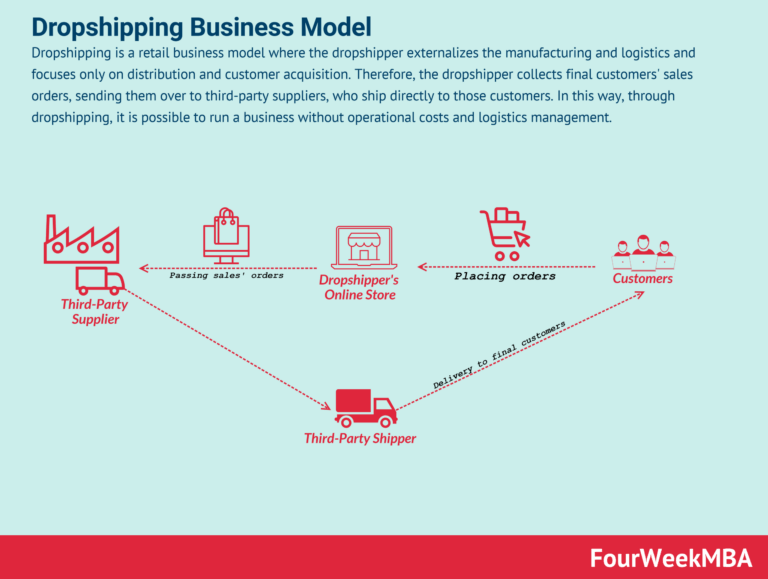How to Start Dropshipping in 2025 (A Beginner’s Guide)
Your Complete Guide to dropshipping amazon products
Welcome to Your Entrepreneurial Journey
Congratulations on taking the first step toward becoming an entrepreneur! Whether you’re dreaming of financial independence, flexibility in your work life, or the satisfaction of building something of your own, starting a dropshipping business on Amazon is an exciting opportunity to turn those dreams into reality.
So, what exactly is dropshipping? In simple terms, dropshipping is a retail fulfillment method where you, the seller, don’t hold any inventory. Instead, when you sell a product, you purchase the item from a third-party supplier who ships it directly to your customer. This means you can focus on marketing and growing your business without the headaches of inventory management or shipping logistics. One of the most appealing aspects of dropshipping is the low startup cost—there’s no need to invest in stock upfront, making it accessible for aspiring entrepreneurs on a budget.
This guide will serve as your complete roadmap to success in the world of dropshipping Amazon products. We’ll cover everything you need to know to get started, from identifying winning products that will fly off the virtual shelves to setting up your Amazon store and executing your first sale. You’ll learn how to conduct product research, evaluate suppliers, and optimize your listings to attract potential buyers. Each section is designed to provide actionable insights and strategies, empowering you to make informed decisions as you navigate this exciting business model.
Moreover, this guide will delve into key criteria for selecting dropshipping products across various popular niches, such as Home & Kitchen, Beauty & Personal Care, Electronics, and more. Understanding these categories will help you identify profitable opportunities that align with market trends and consumer demands.
As you embark on this journey, remember that every successful entrepreneur started with a single step. With dedication, creativity, and the knowledge you’ll gain from this guide, you can transform your entrepreneurial aspirations into a thriving online business. So, gear up, stay motivated, and let’s turn your dropshipping dreams into reality!
What You’ll Learn In This Guide
- Your Complete Guide to dropshipping amazon products
- How Does Dropshipping Actually Work? A Step-by-Step Breakdown
- The Pros and Cons of Dropshipping: Is It Right for You?
- Step 1: Finding a Profitable Niche and Winning Products
- Step 2: Choosing the Right Dropshipping Suppliers
- Step 3: Building Your Online Store
- Step 4: Marketing Your Dropshipping Business to Get Sales
- Common Mistakes to Avoid as a Beginner
- Frequently Asked Questions (FAQs) about dropshipping amazon products
- Conclusion: Your Next Steps to Launching Your Business
- Important Disclaimer
How Does Dropshipping Actually Work? A Step-by-Step Breakdown
Understanding the Dropshipping Process
If you’re looking to start a dropshipping business on Amazon, it’s crucial to grasp how the model operates. Think of yourself as the digital storefront and middleman, connecting customers with suppliers without ever handling the products yourself. Here’s a step-by-step breakdown of how dropshipping works:
1. Customer Places an Order on Your Online Store
The journey begins when a customer browses your Amazon store and finds a product they want to purchase. This could be anything from a trendy gadget to a stylish piece of clothing. They add the item to their cart and proceed to checkout, where they provide payment and shipping details. At this point, you’ve made your first sale!
2. You Receive the Payment
Once the customer completes their purchase, the payment is processed through Amazon’s secure platform. You receive the full retail price of the product, minus any fees that Amazon may charge for listing and selling. This is your revenue, which you will use to pay the supplier. Keeping track of these transactions is essential, as it helps you manage your finances and assess your profit margins.
3. You Forward the Order to Your Supplier
After you receive the payment, it’s time to fulfill the order. You’ll send the order details to your supplier—this can often be done automatically through an integration or manually via email or a web portal. You’ll provide them with the customer’s shipping information, ensuring that the order is processed swiftly. At this stage, you will also pay the supplier the wholesale price of the product, which is typically lower than the retail price you charged the customer. This transaction is crucial, as it sets the stage for your profit margin.
4. The Supplier Ships the Product Directly to the Customer
Once the supplier receives your order and payment, they will package and ship the product directly to the customer’s address. This step is where the magic happens: the customer receives their product, and you never had to touch the inventory. The supplier handles all logistics, including shipping costs and delivery times, which allows you to focus on marketing and growing your business.
The Flow of Money and Goods
To clarify the flow of money and goods in the dropshipping model, imagine a relay race. You, as the digital storefront, pass the baton (the order) to your supplier. The customer’s payment is the energy that fuels the race.
- Money Flow:
- Customer pays you the retail price.
- You pay your supplier the wholesale price.
-
The difference between these two prices is your profit.
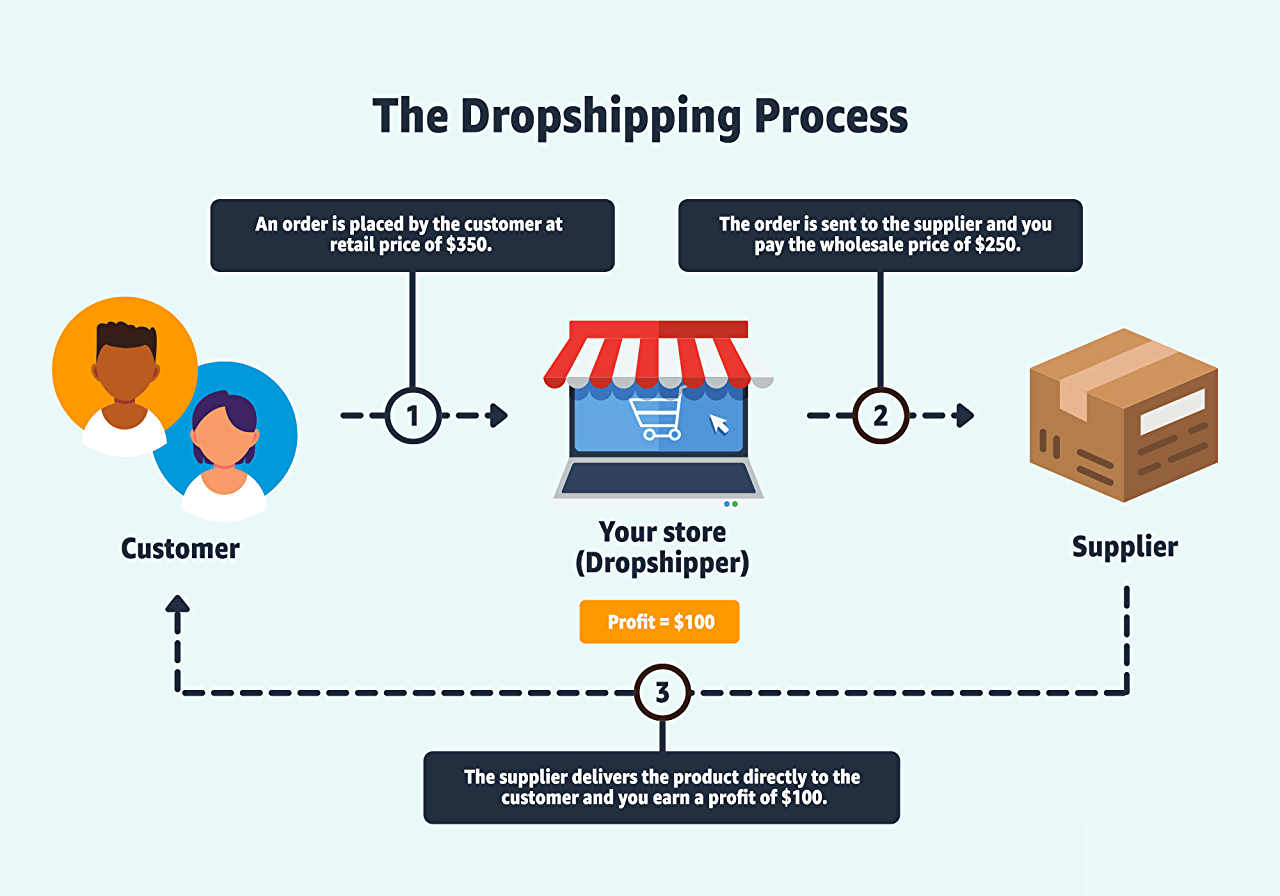
-
Goods Flow:
- The customer orders from your store.
- You send the order to the supplier.
- The supplier ships the product directly to the customer.
Conclusion
By understanding these steps, you can effectively manage your dropshipping business. Remember, the key to success in dropshipping is not just in the mechanics but also in choosing the right products, maintaining strong relationships with suppliers, and providing excellent customer service. As you embark on your dropshipping journey, keep learning, adapting, and optimizing your approach. The possibilities are endless, and with dedication, you can build a thriving online business with minimal upfront investment. Happy selling!
The Pros and Cons of Dropshipping: Is It Right for You?
Advantages of Dropshipping (Pros) | Challenges of Dropshipping (Cons)
|—————————————|————————————–|
| Low Financial Risk | Low Profit Margins |
| No need to invest in inventory upfront, reducing financial exposure. | Profit margins can be thin, often ranging from 10% to 30%. |
| Easy to Start | High Competition |
| Minimal setup required; you can launch an online store quickly. | Many sellers target the same products, making it challenging to stand out. |
| Wide Product Selection | Supplier Reliability |
| Access to a vast range of products without the need for storage. | Dependence on suppliers for quality and delivery can lead to issues. |
| Flexibility and Scalability | Customer Service Challenges |
| You can operate from anywhere and easily scale your business. | Handling returns and customer service can be complicated without inventory control. |
| No Inventory Management | Limited Control Over Branding |
| Eliminates the need for warehousing and managing stock. | You have less control over packaging and branding, which can affect customer experience. |
| Access to Market Trends | Potential for Quality Issues |
| Ability to quickly adapt to new trends by adding products to your store. | Variability in product quality from different suppliers can harm your reputation. |
| Low Overhead Costs | Compliance and Legal Issues |
| Running costs are lower since you don’t need a physical storefront. | Navigating regulations, taxes, and compliance can be complex. |
Expanding on the Advantages
One of the most compelling reasons to consider dropshipping is the low financial risk associated with the business model. As a beginner or aspiring entrepreneur, the thought of investing heavily in inventory can be daunting. With dropshipping, you only purchase products after you’ve made a sale, which means you can test the waters without significant upfront costs. This allows you to experiment with different products and niches without risking your savings.
Additionally, starting a dropshipping business is remarkably easy. You don’t need to worry about physical inventory or the complexities of logistics. Platforms like Amazon and Shopify offer user-friendly interfaces that enable you to set up your store quickly. This accessibility makes dropshipping an attractive option for those new to e-commerce who might feel overwhelmed by traditional retail methods.
Another advantage is the wide product selection available to dropshippers. You can offer a diverse range of products without the constraints of physical inventory. This variety allows you to adapt to market trends swiftly, giving you a competitive edge. If a particular product starts gaining traction, you can easily add it to your store without worrying about excess stock.
The flexibility and scalability of dropshipping are also noteworthy. You can run your business from anywhere with an internet connection, whether it’s your home or while traveling. As your business grows, you can scale your operations by adding more products or even expanding to new markets, all without the burden of managing large amounts of inventory.
Addressing the Challenges
While dropshipping offers enticing advantages, it’s essential to be aware of its challenges, particularly low profit margins. Because you are often competing with many other sellers offering similar products, pricing can become a race to the bottom. It’s not uncommon for dropshippers to see profit margins between 10% to 30%, which can make it difficult to build a sustainable income. To combat this, focus on adding value through superior customer service or niche marketing to differentiate your store.
High competition is another significant hurdle in the dropshipping landscape. With the ease of entry, many sellers flock to popular products, creating a saturated market. To overcome this, conduct thorough market research to identify unique products or niches with less competition. Building a strong brand presence and developing a loyal customer base can also help you stand out.
Dependence on suppliers introduces the risk of supplier reliability. If a supplier fails to deliver on time or provides subpar quality, it can damage your reputation and lead to dissatisfied customers. Establishing strong relationships with reliable suppliers and diversifying your supplier base can mitigate this risk.
Lastly, customer service challenges can arise due to the nature of dropshipping. Handling returns and complaints can be complicated when you don’t have direct control over the products. Ensure you have clear communication with your suppliers regarding their return policies and establish a customer service strategy to handle any issues effectively.
Conclusion
Dropshipping can be a viable path for aspiring entrepreneurs looking to enter the e-commerce space with minimal investment. By weighing the pros and cons carefully, you can make an informed decision about whether this business model aligns with your goals. With the right strategies, a commitment to quality, and a customer-first mindset, you can navigate the challenges of dropshipping and build a successful online business.
Step 1: Finding a Profitable Niche and Winning Products
What Makes a Good Niche?
Choosing the right niche is critical to your success in dropshipping on Amazon. A good niche not only has the potential for profitability but also aligns with your interests or passions. Here are several characteristics that define a successful niche:
-
Demand: Look for niches with consistent demand. Products that are trending or have steady year-round sales are ideal. Use tools like Google Trends to analyze search interest over time.
-
Competition: A niche with manageable competition is preferable. Highly saturated markets can make it difficult to gain traction. Aim for niches that have room for new entrants, especially those that cater to specific customer segments or unique product offerings.
-
Profit Margins: Consider the potential profit margins. A good rule of thumb is to aim for products that allow at least a 30% markup over the wholesale price. Higher-priced items can yield more significant profits with fewer sales.
-
Target Audience: Understand your target audience. A well-defined customer segment will help you tailor your marketing efforts and product offerings. Consider demographics, interests, and purchasing behaviors.
-
Longevity: Focus on niches with long-term viability rather than fleeting trends. While it’s tempting to chase the latest fad, building a sustainable business around a niche with enduring appeal will yield better results.
How to Brainstorm Niche Ideas
Finding the right niche requires creativity and research. Here are actionable steps to brainstorm niche ideas:
-
Identify Your Interests: Start by listing your hobbies, passions, and areas of expertise. Your enthusiasm for a subject can translate into a more authentic business, making it easier to market your products.
-
Market Research: Use online tools to explore current trends. Websites like Reddit, Quora, and niche forums can provide insights into what people are discussing and what problems they face.
-
Competitor Analysis: Analyze successful dropshipping stores and Amazon sellers. Look for niches that have a proven track record of sales. Tools like Jungle Scout or Helium 10 can help you evaluate competitor products and sales volumes.
-
Social Media Trends: Platforms like Instagram, TikTok, and Pinterest are great for spotting emerging trends. Follow relevant hashtags and influencers to see what products are gaining traction.
-
Google Trends and Keyword Research: Use Google Trends to check the popularity of specific search terms over time. Combine this with keyword research tools to find high-volume, low-competition keywords related to potential niches.
Validating Your Niche
Before committing to a niche, it’s essential to validate your ideas to ensure there’s a real market for your products. Here’s how to validate your niche:
-
Market Size and Demand: Utilize tools like Google Keyword Planner to assess search volume for related keywords. A high search volume indicates strong interest.
-
Customer Feedback: Engage with potential customers through surveys or social media polls. Ask about their pain points and preferences related to your niche.
-
Test Product Listings: Create a few listings for your products on Amazon or Shopify without investing heavily in inventory. Use ads to gauge interest and collect data on engagement and conversion rates.
-
Analyze Competitors: Look closely at competitor reviews and ratings. Identify gaps in their offerings or customer complaints that you can address with your products.
-
Join Online Communities: Participate in forums or groups related to your niche. Engaging with members can provide insights into customer behavior and preferences.
Methods for Finding Winning Products
Once you’ve identified and validated your niche, the next step is to find products that will resonate with your target audience. Here are effective methods for discovering winning products:
-
Supplier Marketplaces: Platforms like AliExpress, Alibaba, and SaleHoo are excellent starting points. They provide access to a vast range of products across various categories. Look for items with high ratings and positive reviews, which indicate reliability and quality.
-
Social Media and Trend Tools: Use social media platforms to spot trending products. Tools like BuzzSumo can help you identify popular content and products that are gaining traction. TikTok and Instagram can be particularly useful for visual products.
-
Amazon Best Sellers and Movers & Shakers: Explore Amazon’s Best Sellers and Movers & Shakers lists to find popular products. These sections highlight items that are currently trending in various categories.
-
Customer Reviews: Read through customer reviews on Amazon and competitor sites to identify what customers appreciate and what they feel is missing. This feedback can guide you in selecting products that solve real problems.
-
Criteria for a Good Dropshipping Product: When evaluating potential products, consider the following criteria:
- Price Point: Look for products that fall within a price range that allows for a healthy profit margin. Ideally, products should sell between $20 and $100, as this range typically attracts impulse buyers.
- Not Easily Found in Stores: Choose products that are not readily available in local retail stores. Unique or niche products are more likely to attract customers who are searching online.
- Problem Solving: Focus on products that solve a specific problem or fulfill a need. Items that improve quality of life or offer convenience are particularly appealing.
- Quality and Supplier Reliability: Ensure that the products you select are of high quality and that your suppliers have a good track record. Poor product quality can lead to returns, negative reviews, and damage to your brand’s reputation.
By following these steps to find a profitable niche and winning products, you’ll be well on your way to establishing a successful dropshipping business on Amazon. Remember to stay flexible, continuously research market trends, and adapt your strategy as needed. Your commitment to learning and growing will be key to your success in this dynamic e-commerce landscape.
Step 2: Choosing the Right Dropshipping Suppliers
Finding Reliable Dropshipping Suppliers
Choosing the right dropshipping suppliers is crucial for the success of your Amazon dropshipping business. The supplier you select will impact your product quality, shipping times, customer service, and ultimately, your brand’s reputation. Below, we will explore some of the most popular platforms for sourcing dropshipping products, including AliExpress, CJ Dropshipping, and USA-Based Suppliers. Each platform comes with its own set of advantages and disadvantages, so understanding these will help you make an informed decision.
AliExpress
AliExpress is one of the largest online retail services based in China, offering a vast array of products at competitive prices. It’s a popular choice for dropshippers due to its extensive product range and user-friendly interface.
Pros:
- Wide Variety of Products: AliExpress features millions of products across countless categories, making it easy to find niche items.
- Low Prices: Products on AliExpress are often available at lower prices, which can help you maintain a higher profit margin.
- No Minimum Order Quantity: You can order one item at a time, which is ideal for dropshippers who want to test products without committing to large inventories.
- Buyer Protection: AliExpress offers a buyer protection program that can help safeguard your investment.
Cons:
- Long Shipping Times: Since most suppliers are based in China, shipping can take several weeks, which may frustrate customers expecting quick delivery.
- Variable Quality: Product quality can be inconsistent. It’s essential to research suppliers and read reviews before placing orders.
- Communication Challenges: Many suppliers may not speak English fluently, leading to potential misunderstandings.
CJ Dropshipping
CJ Dropshipping is another popular platform that connects dropshippers with suppliers. It offers services similar to AliExpress but has a focus on providing better logistics and faster shipping options.
Pros:
- Faster Shipping Options: CJ Dropshipping has warehouses in various countries, including the USA, which can significantly reduce shipping times for your customers.
- Quality Control: CJ conducts quality checks on products before they are shipped, helping ensure you receive high-quality items.
- Integration with Multiple Platforms: CJ Dropshipping integrates seamlessly with various e-commerce platforms, including Shopify and WooCommerce.
- Custom Branding Options: They offer custom packaging and branding options, which can enhance your brand image.
Cons:
- Higher Prices: While you might find better quality products, prices may be slightly higher compared to AliExpress.
- Limited Product Range: Although growing, their product range may not be as extensive as AliExpress.
- Learning Curve: The platform can be more complex for beginners, so you may need some time to familiarize yourself with its features.
USA-Based Suppliers
Sourcing from USA-based suppliers can be an excellent strategy for dropshippers who want to minimize shipping times and enhance customer satisfaction.
Pros:
- Faster Shipping: Orders can often be delivered within a few days, which is a significant advantage in today’s fast-paced e-commerce environment.
- Better Customer Service: Many USA-based suppliers offer superior customer service, including easier communication and more straightforward returns.
- Quality Assurance: Products sourced from local suppliers are often of higher quality and adhere to stricter regulations.
Cons:
- Higher Product Costs: Prices for products from USA-based suppliers may be higher, which could impact your profit margins.
- Limited Product Variety: Depending on your niche, you may find fewer product options available compared to international suppliers.
- Minimum Order Requirements: Some suppliers may have minimum order quantities, which can be a barrier for new dropshippers.
What to Look for in a Good Supplier
When evaluating potential dropshipping suppliers, it’s essential to consider several key factors. Here’s a checklist to help you identify the right supplier for your business:
-
Communication: Ensure that the supplier is responsive and communicates effectively. Quick responses to inquiries can indicate good customer service.
-
Shipping Times: Check the estimated shipping times for the products you plan to sell. Ideally, you want suppliers who can deliver quickly to maintain customer satisfaction.
-
Product Quality: Look for suppliers with positive reviews and ratings. Ordering samples can also help you assess the quality of products before listing them in your store.
-
Return Policies: Understand the supplier’s return and refund policies. Clear and fair policies can save you from potential headaches in the future.
-
Pricing: Compare prices among various suppliers. Ensure that you have a healthy profit margin while remaining competitive in the marketplace.
-
Reliability: Research the supplier’s track record. Look for reviews and testimonials from other dropshippers to gauge their reliability and service quality.
-
Integration Capabilities: If you plan to use a specific e-commerce platform, check whether the supplier can integrate smoothly with it for order processing and inventory management.
-
Scalability: Consider whether the supplier can handle increased order volume as your business grows. A good supplier should be able to scale with you.
-
Product Range: Assess whether the supplier offers a wide variety of products that align with your niche, allowing you to expand your catalog as needed.
Final Thoughts
Selecting the right dropshipping supplier is a critical step in your journey to building a successful Amazon business. Take the time to evaluate your options carefully, keeping in mind the specific needs of your target market and your business goals. By choosing a reliable supplier, you can focus on marketing and growing your business while ensuring that your customers receive high-quality products in a timely manner. Remember, the right supplier can be a game-changer in your dropshipping journey!
Step 3: Building Your Online Store
Setting Up Your Online Store for Dropshipping on Shopify
Building an online store for your dropshipping business is an exciting step in your entrepreneurial journey. Shopify is one of the most popular e-commerce platforms, especially for beginners, due to its user-friendly interface, robust features, and extensive app ecosystem. In this guide, we will walk you through the essential steps to set up your Shopify store effectively.
1. Choosing a Shopify Plan
Before diving into the design and functionality of your store, you’ll need to choose a Shopify plan that suits your needs. Shopify offers several pricing tiers, including:
- Basic Shopify: Ideal for new businesses with essential features, including an online store, unlimited products, and 24/7 support.
- Shopify: This plan adds more advanced reporting and features, perfect for growing businesses.
- Advanced Shopify: Designed for larger businesses needing advanced reporting and third-party shipping rates.
Start with the Basic Shopify plan if you’re just starting out. You can always upgrade as your business grows. Shopify also offers a 14-day free trial, allowing you to explore the platform without any commitment.
2. Picking a Theme
Your store’s theme plays a crucial role in its overall look and feel. Shopify offers a variety of free and paid themes that cater to different niches. Here’s how to choose the right one:
- Identify Your Niche: Select a theme that aligns with the products you plan to sell. For example, a minimalist theme works well for fashion, while a vibrant theme may suit toys and games.
- Mobile Responsiveness: Ensure the theme is mobile-friendly, as a significant portion of online shopping is done via mobile devices.
- Customization Options: Look for themes that allow easy customization. You want to personalize your store to reflect your brand identity.
To pick a theme, navigate to the Online Store section in your Shopify admin, click on Themes, and explore the Shopify Theme Store.
3. Setting Up Essential Pages
Establishing essential pages is critical for building trust and providing information to your customers. Here are the key pages you should create:
- About Us: Share your story, mission, and values. This helps humanize your brand and connects with customers.
- Contact Us: Provide multiple ways for customers to reach you, including an email address, phone number, and a contact form.
- Policies: Clearly outline your store policies, including:
- Return Policy: Explain your return process, including timeframes and conditions.
- Shipping Policy: Detail shipping times, costs, and methods.
- Privacy Policy: Inform customers how you handle their personal information.
To create these pages, go to the Online Store section, click on Pages, and then Add Page for each.
4. Installing Key Apps
To streamline your dropshipping operations, you’ll need to install some essential apps. Here are a couple of must-haves:
- Import Tool: Apps like DSers or CJ Dropshipping allow you to easily import products from suppliers to your store. They also help manage orders and inventory.
- Marketing Tools: Consider apps like Klaviyo for email marketing and Oberlo for product sourcing (if you prefer a different approach).
- SEO Tools: Apps like Plug in SEO can help optimize your store for search engines, driving organic traffic to your products.
To install apps, go to the Shopify App Store, search for the apps you need, and follow the installation instructions.
5. Setting Up Payment Gateways
To process payments, you’ll need to set up payment gateways. Shopify supports various payment options, including:
- Shopify Payments: This is the easiest option as it integrates seamlessly with your store and has lower transaction fees.
- PayPal: Widely used and trusted by customers, it’s essential to offer this option.
- Third-Party Payment Processors: If you want to use providers like Stripe or Authorize.net, make sure to check their fees and compatibility with Shopify.
To set up your payment gateways, navigate to Settings in your Shopify admin, click on Payments, and follow the prompts to configure your preferred payment options.
Alternative: WooCommerce
While Shopify is a fantastic choice for beginners, you may also consider WooCommerce as an alternative. WooCommerce is a plugin for WordPress that allows you to turn your site into an online store. It’s highly customizable and offers a wide range of plugins. However, it may require more technical knowledge to set up and manage compared to Shopify.
Conclusion
Building your online store on Shopify is an exciting journey that opens doors to endless opportunities in the dropshipping world. By carefully choosing your plan, selecting a fitting theme, setting up essential pages, installing key apps, and configuring payment gateways, you will lay a solid foundation for your business. Remember, your store is a reflection of your brand, so take the time to create an engaging and user-friendly shopping experience. Now, let’s move forward and start selling!
Step 4: Marketing Your Dropshipping Business to Get Sales
Social Media Marketing (TikTok & Instagram)
Social media platforms like TikTok and Instagram are powerful tools for promoting your dropshipping business. They offer a visual way to showcase your products and engage with potential customers. Here are some actionable tips to help you leverage these platforms effectively:
-
Create Engaging Content
Focus on creating visually appealing content that highlights your products. Use high-quality images and videos to showcase how your items can be used in real-life scenarios. For example, if you’re selling kitchen gadgets, create short videos demonstrating their functionality and ease of use. Utilize trending sounds and challenges on TikTok to increase visibility. -
Utilize Stories and Reels
Both Instagram Stories and Reels can help you connect with your audience in a more personal way. Share behind-the-scenes content, customer testimonials, or even how your products are made. For instance, if you sell pet supplies, showcase happy pets using your products in a fun, engaging manner. -
Engage with Your Audience
Respond to comments, direct messages, and mentions promptly. This interaction builds community and trust. Consider hosting Q&A sessions or polls in your Stories to encourage participation. For example, you could ask your audience what new products they’d like to see in your store. -
Leverage Influencer Partnerships
Collaborate with micro-influencers who align with your brand. They often have a highly engaged audience and can provide authentic endorsements. Reach out to influencers who cater to your niche; for instance, if you sell fitness gear, partner with fitness enthusiasts to showcase your products in action. -
Use Hashtags Strategically
Research and incorporate relevant hashtags to increase the visibility of your posts. Use a mix of popular and niche-specific hashtags to reach a broader audience. For example, if you’re selling eco-friendly products, use hashtags like #EcoFriendly, #SustainableLiving, and #GreenProducts to attract like-minded customers.
Paid Advertising (Facebook/Instagram Ads)
Paid advertising can be an effective way to drive targeted traffic to your dropshipping store. Here are some strategies to get started:
-
Define Your Target Audience
Use Facebook’s detailed targeting options to reach your ideal customers. Identify demographics, interests, and behaviors that align with your products. For example, if you sell beauty products, target audiences interested in skincare, beauty blogs, and wellness. -
Create Compelling Ad Copy and Visuals
Your ads should capture attention quickly. Use eye-catching images or videos and concise, persuasive copy that highlights your product’s benefits. For instance, if you’re promoting a new kitchen gadget, emphasize how it saves time and makes cooking easier. -
Utilize Retargeting Campaigns
Set up retargeting ads to reach people who have previously visited your website but didn’t make a purchase. This reminds them of your products and encourages them to complete their purchase. For instance, if a customer viewed a specific item, show them an ad featuring that product along with customer reviews or discounts. -
A/B Test Your Ads
Experiment with different ad formats, images, and copy to see what resonates best with your audience. Create multiple versions of your ads and monitor their performance. For example, you could test a video ad against a carousel ad to see which generates more engagement and conversions. -
Monitor and Optimize Your Campaigns
Regularly check your ad performance metrics, such as click-through rates (CTR) and conversion rates. Adjust your targeting, budget, and ad content based on what works best. If you notice that certain products are performing better, consider increasing the budget for those specific ads.
Search Engine Optimization (SEO)
Optimizing your online store for search engines is crucial for attracting organic traffic. Here are some essential SEO strategies:
-
Keyword Research
Identify relevant keywords related to your products. Use tools like Google Keyword Planner or Ubersuggest to find keywords that potential customers are searching for. For example, if you sell yoga mats, target keywords like “best yoga mats” or “eco-friendly yoga mats.” -
Optimize Product Listings
Incorporate your target keywords into your product titles, descriptions, and meta tags. Make sure your descriptions are detailed and highlight the benefits of the products. For instance, instead of simply stating “Yoga Mat,” use “Eco-Friendly Non-Slip Yoga Mat for Ultimate Comfort and Support.” -
Create Valuable Content
Start a blog on your website where you can share tips, guides, or product reviews related to your niche. This not only helps with SEO but also positions you as an authority in your industry. For example, if you sell pet products, create content about pet care tips or product comparisons. -
Build Backlinks
Reach out to relevant blogs or websites in your niche to secure backlinks. Guest posting or collaborating on content can help drive traffic to your store and improve your search engine ranking. For instance, if you sell fitness equipment, write a guest post for a fitness blog and include a link back to your store. -
Optimize for Mobile
Ensure that your website is mobile-friendly, as many users shop on their phones. A responsive design improves user experience and can positively impact your search rankings. Test your website on various devices to ensure it loads quickly and looks good on all screens.
Email Marketing
Email marketing remains one of the most effective ways to connect with your audience and drive sales. Here’s how to get started:
-
Build Your Email List
Use lead magnets such as discounts, free resources, or exclusive content to encourage visitors to subscribe to your email list. For example, offer a 10% discount for signing up or create a downloadable guide related to your niche. -
Segment Your Audience
Divide your email list into segments based on customer behavior, preferences, or purchase history. This allows you to send targeted emails that resonate with each group. For instance, send tailored recommendations to customers who previously bought beauty products. -
Craft Compelling Email Campaigns
Write engaging subject lines and personalized content that encourages recipients to open and click through your emails. Use clear calls-to-action (CTAs) that guide them toward making a purchase. For example, “Don’t Miss Out on Our Limited-Time Offer!” can create a sense of urgency. -
Automate Your Email Sequences
Set up automated email sequences for welcome emails, abandoned cart reminders, and post-purchase follow-ups. This saves time and ensures consistent communication with your customers. For instance, send a reminder to customers who left items in their cart, along with a discount code to encourage them to complete their purchase. -
Analyze and Optimize
Regularly review your email marketing metrics, such as open rates, click-through rates, and conversion rates. Use this data to refine your email campaigns and improve performance. For example, if you find that certain subject lines lead to higher open rates, consider using similar phrasing in future emails.
By implementing these marketing strategies, you can effectively promote your dropshipping business on Amazon and drive sales. Remember to track your performance, adjust your tactics based on what works, and stay engaged with your audience. With persistence and creativity, you can build a successful online store.
Common Mistakes to Avoid as a Beginner
1. Choosing a Bad Niche
One of the most significant pitfalls for beginners in dropshipping is selecting a niche that lacks demand or is overly saturated. A poorly chosen niche can lead to minimal sales and wasted resources.
Solution: Conduct thorough market research using tools like Google Trends, AMZScout, or Jungle Scout to identify trending products and assess competition. Look for niches that have consistent demand but aren’t oversaturated. Focus on your interests or passions, as this will keep you motivated and informed about your target market.
2. Not Testing Products
Many beginners make the mistake of assuming that a product will sell based on trends or personal preferences without testing its viability. This can lead to carrying products that don’t resonate with customers.
Solution: Start with a small batch of products to gauge customer interest. Use A/B testing on different listings, descriptions, and pricing strategies. Monitor sales data and customer feedback closely to identify which products perform best, then scale your offerings accordingly.
3. Poor Customer Service
Customer service is often overlooked by new dropshippers, yet it is crucial for building trust and loyalty. Poor service can lead to negative reviews, which can severely impact your business.
Solution: Prioritize customer service by responding promptly to inquiries and addressing issues professionally. Use automated tools for FAQs and consider hiring a virtual assistant for customer support. Encourage feedback and continually improve your service based on customer suggestions.
4. Ignoring Shipping Times
Long shipping times can frustrate customers and lead to abandoned carts. Beginners often underestimate the importance of shipping logistics in the dropshipping model.
Solution: Clearly communicate shipping times on your product pages. Choose suppliers who offer reliable and fast shipping options. Consider using suppliers located closer to your target market to reduce shipping times. Always keep your customers informed about their order status.
5. Unrealistic Profit Expectations
Many beginners enter the dropshipping business with inflated expectations regarding profits. This can lead to disappointment and hasty decisions, such as cutting prices or switching suppliers too frequently.
Solution: Set realistic goals based on your market research and operational costs. Understand that building a successful dropshipping business takes time and effort. Create a detailed financial plan that includes all potential costs and projected sales to help manage expectations.
6. Neglecting Marketing Strategies
Relying solely on the Amazon platform for traffic is a common mistake. Beginners often underestimate the need for effective marketing to drive sales.
Solution: Develop a comprehensive marketing strategy that includes SEO, social media marketing, and email campaigns. Utilize Amazon’s advertising options to increase visibility. Engage with potential customers on social media to build a brand presence and drive traffic to your listings.
7. Not Building a Brand
Many beginners focus only on sales without considering the importance of branding. Failing to establish a unique brand can make it challenging to differentiate from competitors.
Solution: Create a cohesive brand identity that resonates with your target audience. This includes designing a professional logo, crafting a compelling brand story, and maintaining consistent messaging across all platforms. Building a brand helps foster customer loyalty and can lead to repeat sales.
8. Overlooking Legal Requirements
Starting a dropshipping business without understanding the legal implications can lead to serious consequences. Beginners may fail to comply with regulations, leading to fines or even business closure.
Solution: Research the legal requirements in your area, including business licenses, tax obligations, and consumer protection laws. Consult with a legal professional if necessary to ensure your business operates within the law.
9. Failing to Optimize Listings
Poorly optimized product listings can hinder sales. Beginners often neglect to write compelling product descriptions or use relevant keywords.
Solution: Spend time crafting engaging product descriptions that highlight benefits and features. Use high-quality images and videos to showcase your products. Conduct keyword research to ensure your listings are optimized for search engines, making it easier for customers to find your products.
10. Ignoring Analytics
Finally, many beginners overlook the importance of analytics in tracking their business performance. Without analyzing data, it’s challenging to identify areas for improvement.
Solution: Regularly review your sales data, customer behavior, and marketing performance. Use tools like Google Analytics and Amazon Seller Central to gain insights into your business. Adjust your strategies based on the data to optimize performance and drive growth.
By avoiding these common mistakes and implementing the suggested solutions, you can set a solid foundation for your dropshipping business on Amazon. Stay persistent, keep learning, and adapt to the ever-changing e-commerce landscape for long-term success.
Frequently Asked Questions (FAQs) about dropshipping amazon products
1. What is dropshipping and how does it work on Amazon?
Dropshipping is an order fulfillment method where you, as the seller, do not keep products in stock. Instead, when a customer makes a purchase, you buy the item from a third-party supplier who then ships it directly to the customer. On Amazon, you list products from your supplier in your store. When an order comes in, you forward it to the supplier, who takes care of the shipping. This model allows you to run your business without the hassle of managing inventory or logistics.
2. How much money do I need to start dropshipping on Amazon?
The initial investment can vary widely, but you can start with as little as $100 to $500. This amount typically covers your Amazon seller account fees, initial marketing costs, and any necessary tools or software for managing your listings. Remember, while dropshipping minimizes upfront costs, allocating a budget for advertising and potential returns is wise.
3. Do I need to register a company to start dropshipping on Amazon?
While it’s not strictly required to register a formal business entity to start dropshipping, it is highly recommended. Registering a business helps you establish credibility, manage taxes more effectively, and protect your personal assets. Many entrepreneurs choose to register as a sole proprietorship, LLC, or corporation based on their needs and goals.
4. How do I find reliable suppliers for dropshipping on Amazon?
Finding reliable suppliers is crucial to your success. You can start by researching dropshipping directories like SaleHoo or Doba, or consider using platforms like AliExpress and Oberlo. Look for suppliers with positive reviews, good communication, and fast shipping times. Always order samples to check product quality before listing them in your store.
5. What are the best products to dropship on Amazon?
The best products for dropshipping are often those that are trending, have steady demand, and fit within profitable niches. Categories like Home & Kitchen, Beauty & Personal Care, and Pet Supplies have shown strong sales potential. Tools like AMZScout can help you analyze product performance and identify winning items based on sales data and competition.
6. How do I handle returns and customer service in dropshipping?
Returns can be tricky in dropshipping since you don’t handle the inventory. Most suppliers will have their return policies, which you should familiarize yourself with. Generally, it’s best to communicate with your supplier about how to manage returns. For customer service, maintain clear communication with your customers and provide prompt responses to their inquiries to build trust and loyalty.
7. Can I use my own branding when dropshipping on Amazon?
Yes, you can use your branding, but there are some limitations. When dropshipping, you typically sell products that are already branded by the supplier. However, you can create a brand around your store and invest in marketing and packaging that reflects your brand identity. Consider using private label products if you want to have more control over branding.
8. What are the fees associated with selling on Amazon?
Amazon charges various fees, including a monthly subscription fee for a seller account (which can be waived for individual sellers), referral fees based on the product category, and fulfillment fees if you choose to use Amazon FBA (Fulfillment by Amazon). Always check Amazon’s fee schedule to understand how these costs will affect your profit margins.
9. How do I market my dropshipping store on Amazon?
Marketing on Amazon involves optimizing your product listings with relevant keywords, high-quality images, and compelling descriptions. You can also utilize Amazon Ads to promote your products, increase visibility, and drive sales. Additionally, consider leveraging social media platforms and email marketing to build a customer base outside of Amazon.
10. What challenges should I expect when starting a dropshipping business on Amazon?
Common challenges include intense competition, managing supplier relationships, and ensuring product quality. You may also face issues with customer service and returns since you are not directly handling products. To overcome these challenges, focus on building strong supplier relationships, maintaining excellent customer service, and continually optimizing your listings for better performance. Remember, persistence and adaptability are key to success in dropshipping!
Conclusion: Your Next Steps to Launching Your Business
Your Path to Success in Dropshipping
As you embark on your dropshipping journey, remember that success doesn’t come overnight. It requires dedication, learning, and strategic planning. Here’s a concise roadmap to help you get started effectively:
-
Research Your Niche: Identify a niche that excites you and has proven demand. Use tools like AMZScout to analyze potential products and categories, such as Toys & Games, Home & Kitchen, or Electronics, and assess their sales potential.
-
Find Reliable Suppliers: Establish relationships with trustworthy suppliers who can deliver quality products on time. Platforms like AliExpress and SaleHoo can connect you with vetted suppliers.
-
Set Up Your Store: Choose a selling platform that suits your needs, whether it’s Amazon, Shopify, or another marketplace. Ensure your store is user-friendly, visually appealing, and optimized for conversions.
-
Create Compelling Listings: Write engaging product descriptions and use high-quality images to attract customers. Highlight the unique selling points of your products and optimize for SEO to improve visibility.
-
Market Your Products: Utilize social media, email marketing, and paid ads to drive traffic to your store. Engage with your audience and build a community around your brand.
-
Monitor and Optimize: After launching, keep track of your sales and customer feedback. Use analytics to understand what works and refine your strategy accordingly.
Remember, dropshipping is not a get-rich-quick scheme. It’s a legitimate business model that requires continuous learning and adaptation. Embrace the challenges and celebrate your milestones, however small.
Take Action Today!
Now is the time to take the first step towards launching your dropshipping business. Start by researching your niche and exploring potential products. The road may be challenging, but with determination and the right approach, you can build a successful online business. Don’t wait—your entrepreneurial journey begins now!
Important Disclaimer
⚠️ Important Disclaimer
The information provided in this guide is for educational purposes only. Starting a business involves risks, and success is not guaranteed. Please conduct your own thorough research and consider consulting with financial and legal professionals before making any business decisions.
